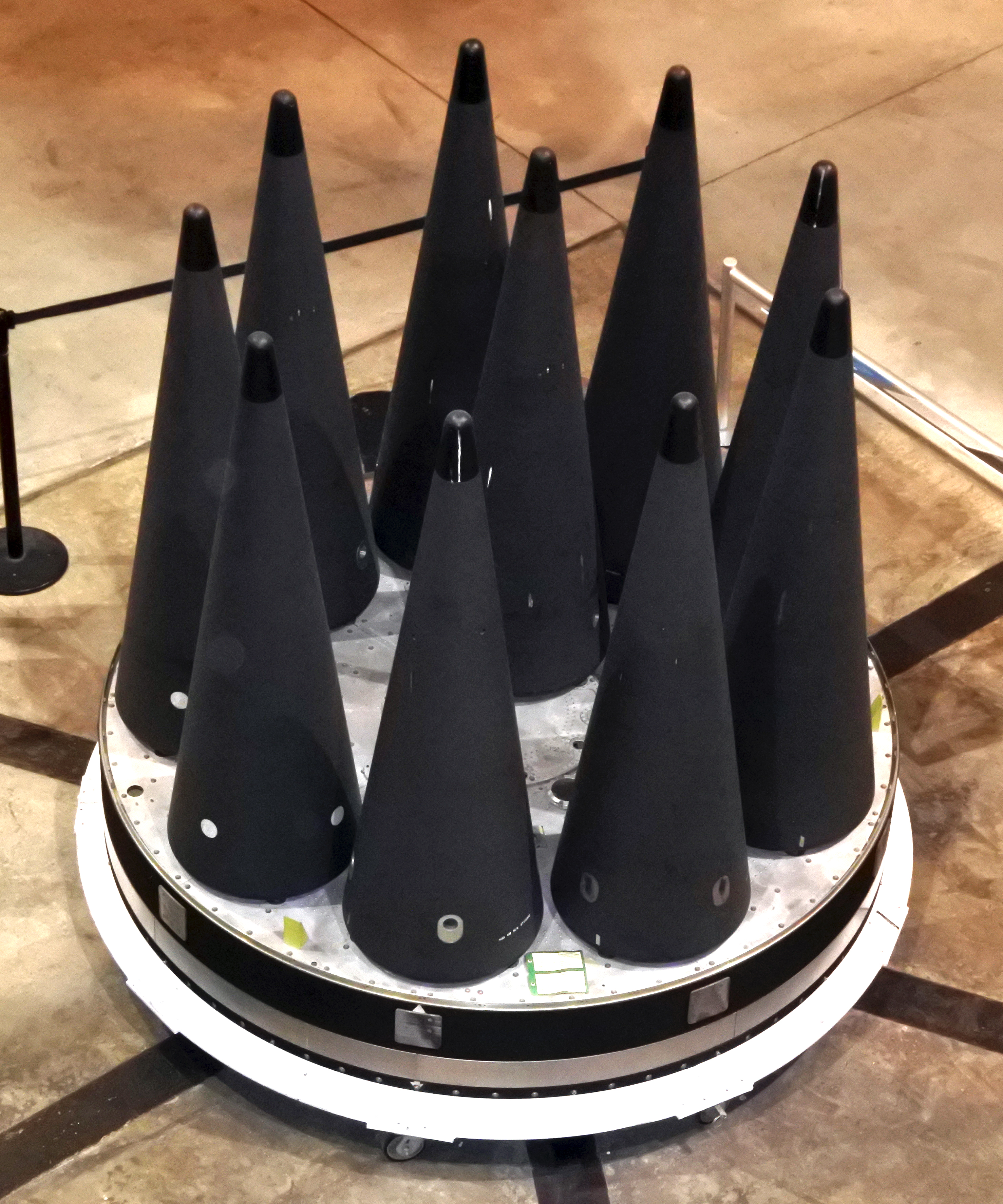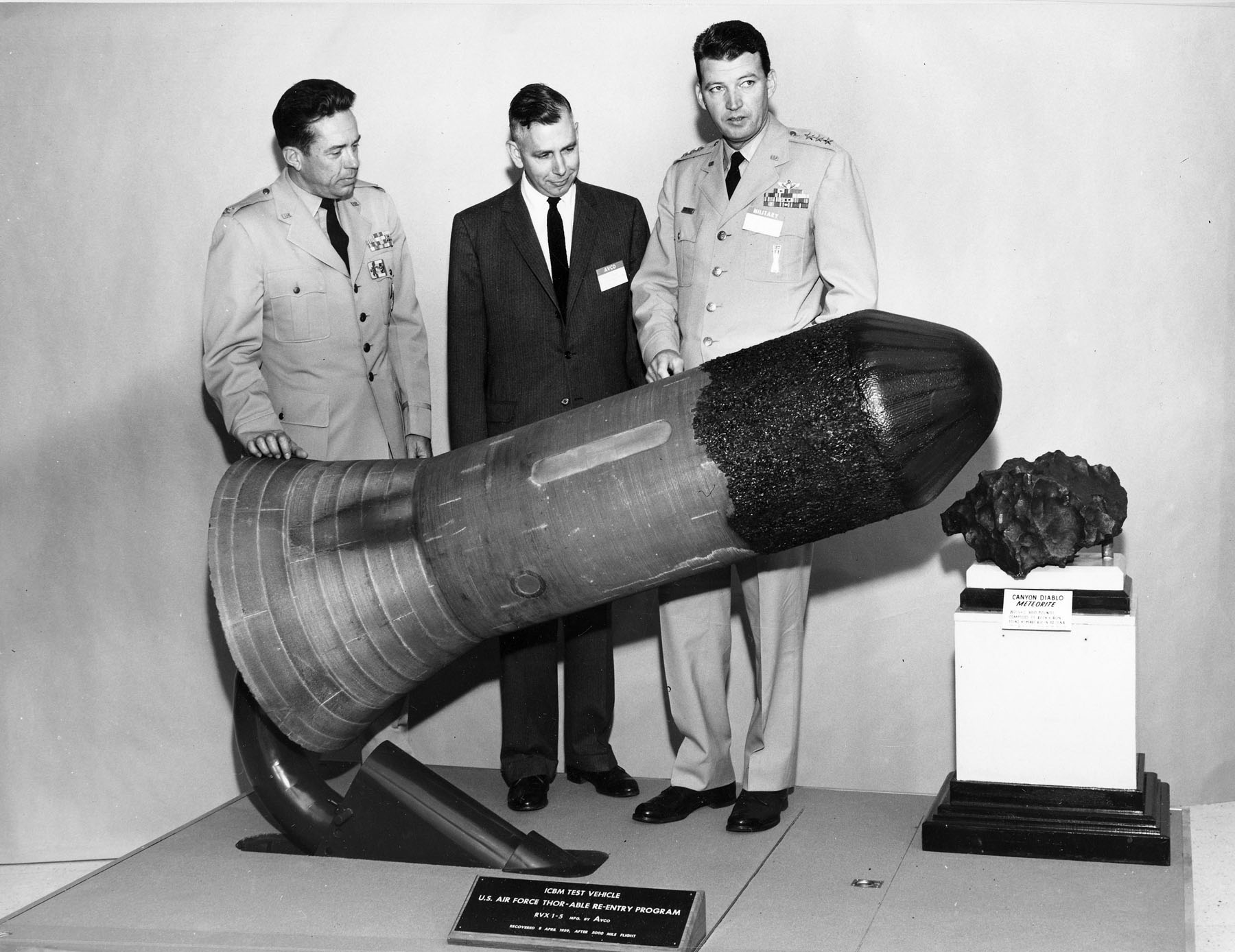|
Hypersonic Glide Vehicle
Hypersonic glide vehicle (HGV) is a type of warhead for ballistic missile that can maneuver and glide at hypersonic speed. It is used on ballistic missiles to significantly change their trajectories. Conventional ballistic missiles follow a predictable ballistic trajectory and are vulnerable to interception by the latest anti-ballistic missile (ABM) systems. HGV makes them unpredictable, allowing them to evade air defenses. Hypersonic glide vehicles are currently subject of an arm race. Countermeasures Boost-glide weapons are generally designed to avoid existing missile defense systems, either by continually maneuvering or by flying at lower altitudes to reduce warning time. This generally makes such weapons easier to intercept using defensive systems intended for lower-altitude "low-tier" targets. Flying at lower speeds than short-range ballistic missile warheads makes them easier to attack. Those that approach with very low terminal attack profiles are even subject to attack by ... [...More Info...] [...Related Items...] OR: [Wikipedia] [Google] [Baidu] |
DF-17 Missile 20221020
The Dongfeng-17 (), is a Chinese solid-fuelled road-mobile medium-range ballistic missile that mounts the DF-ZF Hypersonic Glide Vehicle. The DF-17 along with the DF-ZF, was officially unveiled at the National Day military parade on 1 October 2019, making this China's first operational hypersonic weapon systems and one of the world's first to be put in full initial operation.Henri Kenhmann (2019-10-07) DF-17 : Ce que l’on sait de cette arme hypersonique chinoise (translated, French: ''DF-17: What is known about this Chinese hypersonic weapon'') Design The DF-17 uses the rocket booster from the already operational |
AGM-183
The AGM-183 ARRW ("Air-Launched Rapid Response Weapon") is a hypersonic air-to-ground missile planned for use by the United States Air Force. Developed by Lockheed Martin, the boost-glide vehicle is propelled to a maximum speed of more than Mach 5 by a rocket motor before gliding towards its target. History Development and acquisition In August 2018, the U.S. Air Force awarded a $480 million contract to Lockheed Martin for the development of an air-launched hypersonic weapon. The resulting missile, the AGM-183A ARRW ("Arrow"), underwent an initial captive carry flight test aboard a U.S. Air Force B-52 in June 2019. In February 2020, the Trump Administration proposed a 23 percent increase in funding for hypersonic weapons and, the same month, the U.S. Air Force announced it had decided to move forward with acquisition of the AGM-183A. In March 2020, Under Secretary of Defense for Research and Engineering Michael D. Griffin stated that the United States was "close at hand" ... [...More Info...] [...Related Items...] OR: [Wikipedia] [Google] [Baidu] |
Non-ballistic Atmospheric Entry
Non-ballistic atmospheric entry is a class of atmospheric entry trajectories that follow a non-ballistic trajectory by employing aerodynamic lift in the high upper atmosphere. It includes trajectories such as skip and glide. Skip is a flight trajectory where the spacecraft goes in and out the atmosphere. Glide is a flight trajectory where the spacecraft stays in the atmosphere for a sustained flight period of time. In most examples, a skip reentry roughly doubles the range of suborbital spaceplanes and reentry vehicles over the purely ballistic trajectory. In others, a series of ''skips'' allows the range to be further extended. Non-ballistic atmospheric entry was first seriously studied as a way to extend the range of ballistic missiles, but was not used operationally in this form as conventional missiles with extended range were introduced. The underlying aerodynamic concepts have been used to produce maneuverable reentry vehicles (MARV), to increase the accuracy of some mis ... [...More Info...] [...Related Items...] OR: [Wikipedia] [Google] [Baidu] |
Multiple Independently Targetable Reentry Vehicle
A multiple independently targetable reentry vehicle (MIRV) is an exoatmospheric ballistic missile payload containing several warheads, each capable of being aimed to hit a different target. The concept is almost invariably associated with intercontinental ballistic missiles carrying thermonuclear warheads, even if not strictly being limited to them. By contrast, a unitary warhead is a single warhead on a single missile. An intermediate case is the multiple reentry vehicle (MRV) missile which carries several warheads which are dispersed but not individually aimed. Only the United States, the United Kingdom, France, Russia, China and India are currently confirmed to have deployed MIRV missile systems. Pakistan is developing MIRV missile systems. Israel is suspected to possess or be in the process of developing MIRVs. The first true MIRV design was the Minuteman III, first successfully tested in 1968 and introduced into actual use in 1970. The Minuteman III held three small ... [...More Info...] [...Related Items...] OR: [Wikipedia] [Google] [Baidu] |
Maneuverable Reentry Vehicle
The maneuverable reentry vehicle (abbreviated MARV or MaRV) is a type of warhead for ballistic missiles that is capable of maneuvring and changing its trajectory. MaRV can be capable of autonomously tracking ground targets to make sure the missile does not miss the target, because of the frequent trajectory shifts. This often requires some terminal active homing guidance (like Pershing II active radar homing). Advanced Maneuverable Reentry Vehicle The Advanced Maneuverable Reentry Vehicle (AMaRV) was a prototype MARV built by McDonnell Douglas. Four AMaRVs were made and represented a significant leap in reentry vehicle sophistication. Three of the AMaRVs were launched by Minuteman-1 ICBMs on 20 December 1979, 8 October 1980 and 4 October 1981. AMaRV had an entry mass of approximately 470 kg, a nose radius of 2.34 cm, a forward frustum half-angle of 10.4°, an inter-frustum radius of 14.6 cm, aft frustum half angle of 6°, and an axial length of 2.079 meters. ... [...More Info...] [...Related Items...] OR: [Wikipedia] [Google] [Baidu] |
Hypersonic Flight
Hypersonic flight is flight through the atmosphere below altitudes of about 90 km at speeds greater than Mach 5, a speed where dissociation of air begins to become significant and high heat loads exist. Speeds of Mach 25+ have been achieved below the thermosphere as of 2020. History The first manufactured object to achieve hypersonic flight was the two-stage Bumper rocket, consisting of a WAC Corporal second stage set on top of a V-2 first stage. In February 1949, at White Sands, the rocket reached a speed of , or about Mach 6.7. The vehicle, however, burned on atmospheric re-entry, and only charred remnants were found. In April 1961, Russian Major Yuri Gagarin became the first human to travel at hypersonic speed, during the world's first piloted orbital flight. Soon after, in May 1961, Alan Shepard became the first American and second person to fly hypersonic when his capsule reentered the atmosphere at a speed above Mach 5 at the end of his suborbital flight over the ... [...More Info...] [...Related Items...] OR: [Wikipedia] [Google] [Baidu] |
Hwasong-8
The Hwasong-8 () is a North Korean missile claimed to be mounting a hypersonic glide vehicle, which was first tested on 14 September 2021. The first launch occurred in September, in a month with a total of four missile launches. As it is supposed to be a hypersonic missile, the missile significantly increases the threat that North Korea can put on South Korea, as the higher speed allows it to reach its target in shorter time and additional maneuverability would give it a better chance at defeating missile defenses. Japanese tracking data from a test launch suggest it is a hypersonic ballistic missile, as North Korea described it. Design Background The plans to launch 'hypersonic' missile were already indicated in the 8th Congress of the Workers' Party of Korea as part of the Five-Year Plan for Defense Science Development, where Kim Jong-un also listed other weapons, such as solid-fuel intercontinental ballistic missiles. Although North Korea already has hypersonic missiles wi ... [...More Info...] [...Related Items...] OR: [Wikipedia] [Google] [Baidu] |
Hyper Velocity Gliding Projectile
is a Japanese hypersonic glide vehicle being intended to be used in defending of remote islands. Design and capabilities The HVGP is designed as a standoff missile capable of attacking enemy forces invading remote islands in Japan from outside the enemy weapon engagement zone. The development of the HVGP is based on an incremental approach, with Block 1 being developed as an early version based on existing technology, followed by the development of a performance-enhancing Block 2. Both of them are designed for launch using a solid-propellant rocket motor, with the projectile separating from it at a high altitude and then gliding at hypersonic speeds until impact. In Block 2, glide performance will be further improved by introducing waverider technology. Projectile guidance would be primarily provided by satellite navigation, with inertial navigation system as a backup. Radio-frequency imaging and infrared homing would also be used for guidance when engaging moving targets. Speci ... [...More Info...] [...Related Items...] OR: [Wikipedia] [Google] [Baidu] |
HGV-202F
The HGV-202F is an Indian hypersonic glide vehicle (HGV) being designed, developed, and manufactured by an Indian Defence and Space company HTNP Industries. Production HGV-202F a hypersonic Boost-glide vehicle is being designed, developed, and manufactured by an Indian Defense and Space company HTNP Industries. It is designed to be mounted on a Agni-V and Agni-VI, a type of ballistic missile specifically designed to carry HGVs. According to the Arms Control Association, "Hypersonic glide vehicles are distinguished from traditional ballistic missiles by their ability to maneuver and operate at lower altitudes." Context The maneuverability and high speed of the HGV raises new challenges for conventional missile defense systems. With the disadvantage again swinging toward defensive systems, many in the defense industry are worried hypersonic weapons will rekindle an arms race such as the one during the cold war era. See also * Avangard (hypersonic glide vehicle) * DF-ZF * Hyperso ... [...More Info...] [...Related Items...] OR: [Wikipedia] [Google] [Baidu] |
Common-Hypersonic Glide Body
The Long-Range Hypersonic Weapon (LRHW) is a medium-range surface-to-surface boost-glide hypersonic missile planned for use by the United States Army. The United States Navy intends to procure a ship/submarine-launched variant of the missile as part of the service's Intermediate-Range Conventional Prompt Strike (IRCPS) program. The weapon consists of a large rocket booster that carries the unpowered Common-Hypersonic Glide Body (C-HGB) in a nose cone. Once the booster reaches significant altitude and speed, it releases the C-HGB, which glides at hypersonic speeds as it descends towards its target. Dynetics will build the glide vehicle while Lockheed Martin will build the booster as well as assemble the missile and launch equipment. The C-HGB has been successfully tested twice, in October 2017 and March 2020.Megan Eckstei(1 Nov 2022) US Navy touts hypersonic missile progress ahead of 2025 fieldingArmy LRHW to use 'hot launch'; Navy to use pressurized air to launch from submar ... [...More Info...] [...Related Items...] OR: [Wikipedia] [Google] [Baidu] |
OpFires
Operational Fires (abbreviated as OpFires) is a hypersonic ground-launched system developed by DARPA for the United States Armed Forces. The system deploys a boost glide vehicle. The prime contractor for the program is Lockheed Martin. The system was successfully tested in July 2022 from a Palletized Load System-based launcher vehicle at White Sands Missile Range. Range is thought to be up to 1,000 miles (1,609 kilometers)https://www.navalnews.com/naval-news/2022/08/darpa-updates-on-opfires-hypersonic-missile-test/ See also *Pershing II (similar range) *Long-Range Hypersonic Weapon *AGM-183 ARRW *Hypersonic Air-breathing Weapon Concept The Hypersonic Air-breathing Weapon Concept (HAWC, pronounced "hawk") is a scramjet powered air-launched hypersonic cruise missile project at the U.S. Defense Advanced Research Projects Agency (DARPA), that had a successful hypersonic flight an ... References {{US missiles Military research of the United States Medium-range ballis ... [...More Info...] [...Related Items...] OR: [Wikipedia] [Google] [Baidu] |
Hypersonic Technology Vehicle 2
Hypersonic Technology Vehicle 2 (HTV-2) is an experimental hypersonic glide vehicle developed as part of the DARPA Falcon Project designed to fly in the Mach 20 range. It is a test bed for technologies to provide the United States with the capability to reach any target in the world within one hour (Prompt Global Strike) using an unmanned hypersonic bomber aircraft. Development The Falcon HTV-1 program, which preceded the Falcon HTV-2 program, was conducted in April, 2010. The mission ended within nine minutes from launch. Both these missions are funded by the US Defense Advanced Research Projects Agency (DARPA) to help develop hypersonic technologies and to demonstrate its effectiveness. Under the original plan, HTV-1 was to feature a hypersonic lift-to-drag ratio of 2.5, increasing to 3.5-4 for the HTV-2 and 4-5 for the HTV-3. The actual lift-to-drag ratio of HTV-2 was estimated to be 2.6. HTV-2 was to lead to the development of an HTV-3X vehicle, known as Blackswift, which wou ... [...More Info...] [...Related Items...] OR: [Wikipedia] [Google] [Baidu] |








